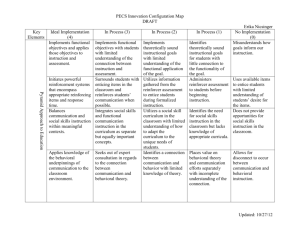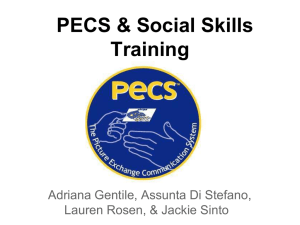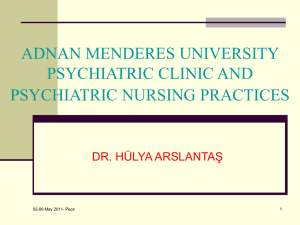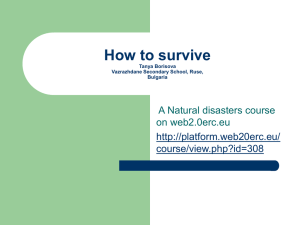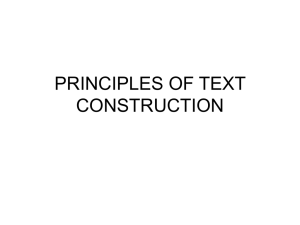Document 5362379
advertisement
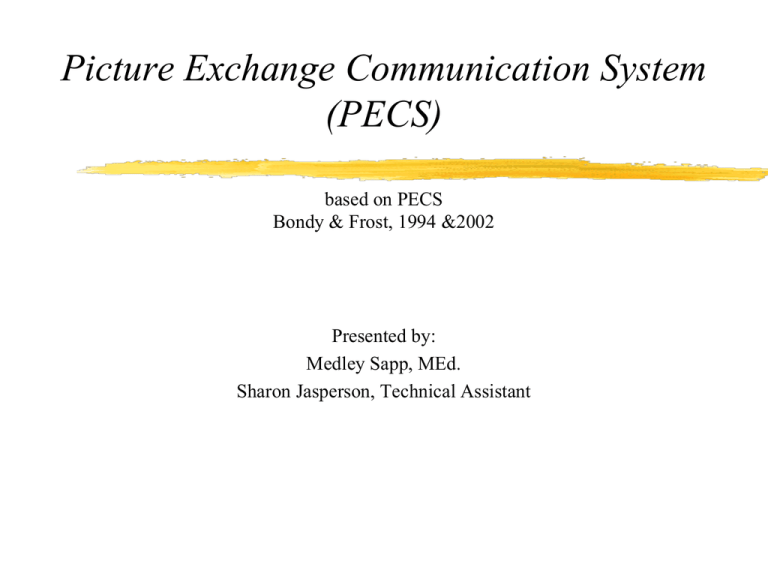
Picture Exchange Communication System (PECS) based on PECS Bondy & Frost, 1994 &2002 Presented by: Medley Sapp, MEd. Sharon Jasperson, Technical Assistant The Important Info: Restrooms Restaurants Introductions Name School Program Grade level Experience with PECS Participation Expectation • Participate in all activities and discussions throughout the day. • Be respectful and attend to colleagues’ input. • Silence cell phones and no texting. • Share questions, grow as a professional, and have fun learning more about PECS in the classroom. Information about the Assistive Technology Department • Website: • http://ccsd.net/departments/assistivetechnology-services PECS: Developed by Andy Bondy and Lori Frost Blends the fields of Applied Behavioral Analysis and Speech Language Pathology http://www.pecs.com/ Pyramid Products Fact or Myth? Schedules are PECS. Choice boards are PECS. Visual Prompts/Cues are PECS. Pointing to a pictures is PECS. Discrimination is a prerequisite to start PECS PECS can only be used with students with autism What is PECS? The Picture Exchange Communication System is a communication training system that teaches a means of functional communication within a social context (Bondy & Frost, 1994). Goal is to develop SPONTANEOUS INITIATION AND COMMUNICATION. (PCS are Picture Communication Symbols) Why PECS vs. Other Systems? PECS requires a student to give a picture to a communicative partner (requesting)with a concrete outcome (reinforcement) (Bondy & Frost, 1994). Other picture systems such as picture pointing focus on labeling rather than requesting(Carr, 1982;Powers&Handelman,1984 in Bondy & Frost, 1994). Picture pointing systems may be good for typically developing children that are intrinsically motivated and reinforced socially. For students with “autism”, concrete reinforcers are often required as they are generally not motivated by social praise. Why PECS vs. Other Systems? CON’T PECS does not require prerequisite imitation or motor skills which may be required for picture pointing or sign language systems (Bondy & Frost, 1994) When is PECS Appropriate? Student is not using functional communication. Student is using functional communication but cannot be understood by unfamiliar listeners. The student does not initiate communication. To increase mean length of utterance. To increase vocabulary. So, How do I get Started? REINFORCERS The only prerequisite for implementing PECS is knowing the reinforcer. Every child is unique and is motivated and reinforced by different items and social rewards. To address individual needs and tastes give reinforcement assessments regularly to have access to powerful reinforcement when teaching the various phases of PECS. Informal Reinforcer Assessment Look at what student is trying to get Ask family about child’s preferences Formally develop a reinforcer hierarchy: - Most desired - Moderately preferred - Tries to avoid Assess at different times of the day Formal Assessment of Reinforcers Select an assortment of reinforcers ( see handout) Put the reinforcers out within the child’s reach and see what he selects. Repeat procedure with different items. Display the items the child has selected in the previous steps. See which of these items he reaches for first. This should be your STRONGEST reinforcer. Begin here PECS Group, 2010 Reinforcer First Strategy Students know what they will get when they make the request. PECS Group, 2010 Determine Symbols to be used Objects Photographs Picture Icons (Pogoboards) Line Drawings Words Organizing PCS Items Blocks/objects in “shoe box” for student use Blocks/objects in “shoe box” for staff use File pictures Tempo Loop fabric on the wall (for students to pick, replace, or staff to replace lost PCS PCS Storage Understanding the Phases of PECS • Teach one phase at a time. • Sequential progression through each phase is the best predictor of success in a student initiating communication, commenting, and requesting that will last a lifetime. Bondy and Frost, 2002 Phase I Phase I teaches students HOW to communicate. Goal=INITIATION; The student MUST go first. PHASE I: Teaching the Physically Assisted Exchange Requires 2 people: Communicative Partner and Prompter. NO verbal prompts. Present one picture at a time (NO BOOKS OR SENTENCE STRIPS ARE USED). Conduct training across the day, not at one time or in one place. Use different reinforcers. Modify symbol/picture to match motor skills (Block example: Jas/Timoteo) PHASE I CON’T Communicative Partner Physical Prompter Entice the student Wait for student initiation R+ student exchange (w/item) (Reach for object) within 1/2 second Physically prompt student: Pair social praise w/R+ pick up, reach, release Time open hand (student reaches for comm. partner) STUDENT Pick up Reach Release Picture of Phase I Example PHASE I ERROR CORRECTION “Backstep” error correction is used when the student makes an error in the task. Example: student picks up picture and drops it before putting in communicative partner’s hand. Physical prompter goes back to the last step performed correctly and prompts from that point through end of task. Phase I PCS Travel Things to Remember The child initiates the training sequence not the silent partner. Do not conduct training in one session. Trials should be spread out throughout the entire. Change trainers right from the beginning so student does not communicate with only one person Change reinforcers as often as possible so student does not come satiated or get tired of the reinforcer. PECS Group, 2010 Practice Phase I Phase I Troubleshooting What happens if the child will not reach for the reinforcer ? Check the strength of the reinforcer. What happens if the child quits handing the reinforcer in the middle of training? Try to end the session with a successful training sequence. What happens if the child can’t see the picture? Try larger pictures, adding color or tactile cards. What happens if the child gets upset when I take a toy? Getting upset is an initiation to go through the training sequence very quickly and give the toy back. PECS Group, 2010 Phase I Data Phase I Criteria For Mastery Independent exchange across 3-5 reinforcers with 2+ communicative partners in 2 different environments. Phase I Review What type of prompts are used? What does the Communicative Partner say when enticing? What does the Physical Prompter say? When is the Communicative Partner’s open hand presented? How quickly is the reinforcer given to the student? How many pictures are used? Is discrimination required? How many trainers are required? Phase II: Distance and Persistence Goal= Travel to the book and travel to the communicative partner; communicate in multiple places with multiple people. Introduce communication book Students carry communication books to all environments. Compile pictures in book. PHASE II: DISTANCE AND PERSISTENCE Introduce communication book. 2 Trainers (just in case!) No verbal prompts used. Teach variety of pictures but only one at a time on front of the book. New skills is increasing distance to communicative partner then increase distance from student to book. PHASE II CON’T Train across the day; student should take the book everywhere they go. This requires 2 trainers. Use a variety of communicative partners. Use backstep error correction as needed. Phase II Communication Book Picture Example Phase II Picture Example Practice Phase II Phase II Troubleshooting Student gets distracted while traveling: decrease the distance, find new, more powerful R+ Student is not able/allowed out of seat: teach the student to “call” the communicative partner (bell, Big Mack) Carrying the book is difficult: use straps, backpacks, possible books located in all environments. Phase II Data Sheet Phase II Criteria for Mastery Student should be able to cross a room to retrieve a picture and travel across the room to the communicative partner. Student should have 5-10 reinforcers. Phase II Review How many trainers are required? How many pictures are used? What does the Communicative Partner say while enticing the student? What does the Physical Prompter say to the student? What is the goal of Phase II? Phase III Discrimination Goal of Phase III=Student chooses among pictures on the communication book. IIIA: Simple Discrimination: Highly preferred vs. distracter IIIB: Conditional Discrimination: Two reinforcers. PHASE III Present 2 items w/pictures; one highly preferred and one non-preferred or a distracter. New skill is choosing “correct” picture; verbally R+ when student touches correct picture. Physical prompter is not needed (Physical prompter is used for initiation; not needed when initiation is spontaneous). Communicative partner may prompt using 4-step error correction. PHASE III CON’T Student chooses incorrect picture= 4-step error correction If the student chooses the incorrect picture, give no social R+ and give the student the item, then go into 4-step error correction. 4-Step Error Correction STUDENT GIVES INCORRECT PICTURE Give item corresponding to picture. (“my turn”) 1. Model or Show correct picture. 2. Prompt; hold hand near correct picture, gesture. Verbal R+ but do not give item. 3. Switch (“do this”) 4. Repeat. 3 trials then errorless (take away distracter) 4-Step Error Correction Practice Phase III A Phase IIIA Data PHASE III CON’T: DISCRIMINATION OF 2 R+ ITEMS; CORRESPONDENCE CHECK Present book w/2 pictures of R+ items with the items. Student requests. Communicative partner, instead of giving items says, “take it”, “go ahead”, etc.) Student takes correct item = R+++ Student takes incorrect item = block access and go into 4-step error correction. (Model/show, prompt, verbal R+, switch, repeat) 4 Step Error Correction with 2 R+ Practice Phase III Correspondence Check Troubleshooting Discrimination Challenges Phase IIIB Data Phase III Mastery Student is able to discriminate from a field of 5 pictures. Final step in discrimination training is to teach the student to look inside of the book for a specific picture. Final Step in Discrimination • When a child is correctly choosing between 5 pictures, teach the child to get the pictures from inside the book. • Remove the pictures from the outside of the book. Open the book and encourage the child to take a picture from there. • When the student is proficient at thumbing through the book and finding a picture there is no longer a need to rotate the pictures. • Organize the book so items are on pages by category. Tabs may be used to help organize categories and separate different pages of the book. PECS Group, 2010 Phase III Review How many trainers are required? What two pictures are used in Phase IIIA? What two pictures are used in Phase IIIB? What error correction procedure is used in Phase III? Phase III iPad app Video PECS and IEP’s In accommodations/modifications; student will use alternate communication system using pictures or other symbols. Write specific goals: Upon seeing and wanting a particular item, and with a picture of that item in reach, student will pick up the picture, reach to person holding the item, and release the picture into that person’s hand. Download objectives from www.pecs.com Pogoboards www.pogoboards.com Look up school user and password @ http://sssd.ccsd.net/assistivetech.html Practice making Picture Communication Symbols to use with PECS. Thank You for Coming!
